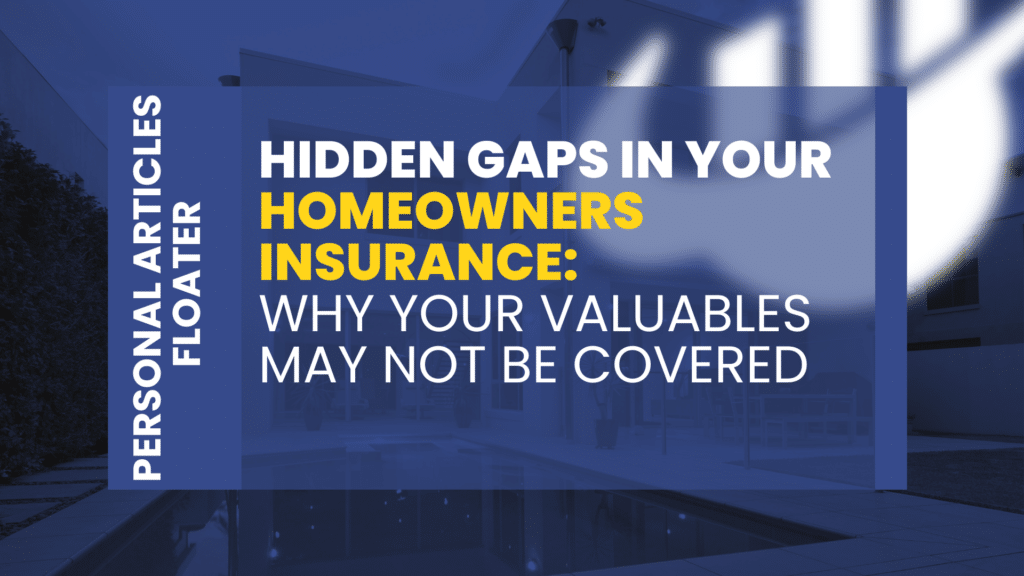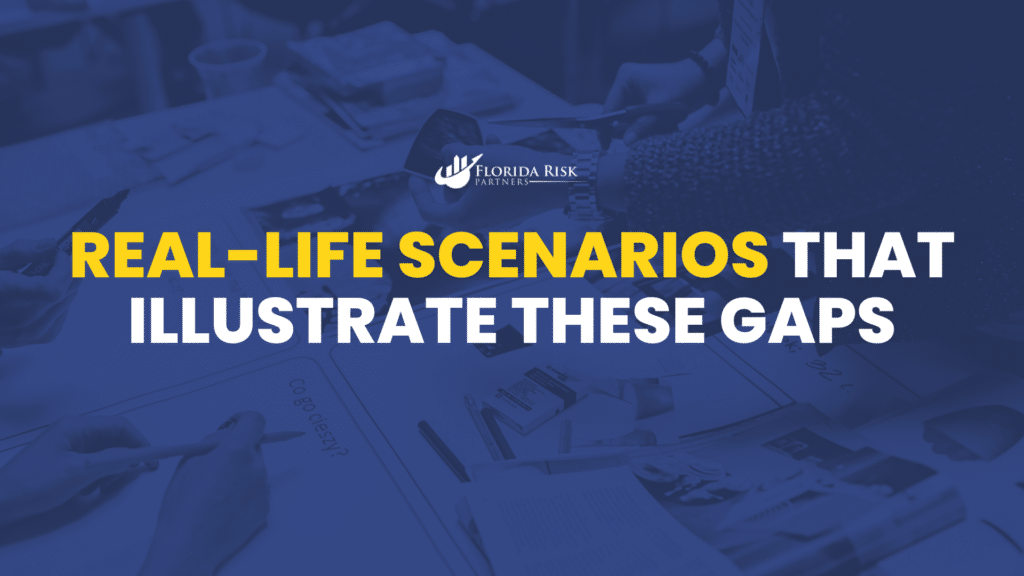-
Main Office: 1434 E. Bloomingdale Ave Valrico, FL 33596-6110
-
Phone: (888) 601-6660
-
Email: info@floridariskpartners.com

Most people feel a sense of security after purchasing a homeowners insurance policy. It feels like you’ve checked a major box—your home is protected, your belongings are covered, and you can sleep soundly knowing that if something goes wrong, you’re financially backed. But what if we told you that assumption could cost you thousands of dollars—and in some cases, even more?
The reality is that many homeowners are unaware of the hidden gaps in their homeowners insurance, especially when it comes to high-value personal property. While your policy does provide personal property protection, it often comes with strict sublimits, specific exclusions, and situational limitations that can leave you underinsured or entirely uninsured in the event of a loss.
This week, we’re pulling back the curtain on the fine print of your homeowners policy and shining a light on where those coverage gaps exist. We’ll also explain how to protect yourself from those gaps using one of the most powerful tools in personal insurance: the Personal Articles Floater (PAF).
Understanding What Your Homeowners Policy Actually Covers
To start, let’s clarify what your standard homeowners policy does and doesn’t do when it comes to your belongings. Most homeowners policies provide what’s called Coverage C – Personal Property, which protects the contents of your home (furniture, electronics, clothing, appliances, etc.) against risks like fire, theft, or vandalism.
This coverage typically insures your personal belongings up to 50% to 70% of your dwelling limit. For example, if your home is insured for $400,000, your personal property coverage might be $200,000 to $280,000. That seems like plenty—until you realize that the real limitations kick in when you look at certain categories of property.
These categories are subject to “special limits of liability”—small caps on how much the insurance company will pay for specific types of items. These limits are usually buried in your policy documents or endorsements, and they’re easy to overlook.
Common Categories with Coverage Gaps
Let’s look at a few examples of categories where these hidden sublimits often show up:
1. Jewelry, Watches, and Furs
This is probably the most well-known—and misunderstood—limitation in homeowners insurance. Most policies limit coverage for theft of jewelry, watches, and furs to just $1,500 to $2,500 total. That’s not per item—that’s the cap for all of those items combined.
So if your $8,000 diamond engagement ring is stolen, your insurance may only pay $1,500 or $2,000—leaving you to cover the remaining $6,000+ out of pocket.
2. Firearms
Homeowners policies often limit the coverage for theft of firearms to around $2,000 to $2,500. This might be enough for a single handgun or basic rifle, but it falls short for collectors or anyone who owns specialty, antique, or custom firearms.

3. Silverware, Goldware, and Pewterware
These items are typically limited to $2,500 or less. For anyone who owns heirloom silver sets or high-end utensils passed down through generations, this is a major exposure.
4. Electronics
Electronics are often covered—but only to a point. Coverage may be restricted if the item is used for business purposes (such as a laptop used for remote work or a DSLR camera used for side gigs), and depreciation is commonly applied. Plus, there are often per-item or aggregate limits in place.
5. Musical Instruments
If you own musical instruments and use them for performance or income, your homeowners policy may either limit coverage severely or exclude it entirely under business use provisions. Even if used for hobby purposes, you may not have full replacement value unless the item is scheduled.
6. Collectibles and Antiques
High-value collections—such as coins, stamps, comic books, vintage wines, or sports memorabilia—are often not fully covered under standard policies. Many carriers place strict limits on collectibles, and coverage may exclude breakage, mysterious disappearance, or market appreciation.
7. Fine Art
Art is another big blind spot. Whether it’s a $3,000 painting you picked up on vacation or a $25,000 commissioned piece hanging in your foyer, the average policy doesn’t come close to providing sufficient protection unless you’ve scheduled the piece separately.
Situational Coverage Gaps You Need to Know About
Even beyond category-specific sublimits, there are situational exclusions that can dramatically affect whether or not a claim is paid. Here are some of the most common:
Loss and Mysterious Disappearance
Your homeowners policy may exclude coverage for personal property that is lost or mysteriously disappears. This is crucial for small, high-value items like rings, earrings, or watches. If you misplace your wedding band or it slips off at the beach, your policy may not pay anything at all.
Off-Premises Losses
Most homeowners policies do include some off-premises coverage (often up to 10% of your personal property limit), but this comes with asterisks. Thefts from hotel rooms, luggage loss, or damage during a move may not be covered or may be capped at a much lower limit.
Depreciation and Actual Cash Value Settlements
Unless your homeowners policy includes replacement cost coverage, claims are paid on an actual cash value basis. The insurance company will deduct depreciation. They will pay only what the item is worth at the time of loss, not the replacement cost.
Real-Life Scenarios That Illustrate These Gaps

To put all of this into perspective, here are a few examples of claims we’ve seen or heard about that illustrate just how big these gaps can be:
- A client had a $10,000 designer jewelry collection stolen while on vacation. The homeowners policy only paid $2,000 due to theft sublimits, and did not provide coverage for several items that were not documented.
- A photographer had $6,000 worth of camera gear stolen from their car. The gear was used for a part-time business, so the carrier denied the claim entirely under the business use exclusion.
- A musician’s $4,500 cello was damaged while flying to a performance. The claim was denied because the item wasn’t scheduled and was being used for professional purposes.
These are not rare cases—they happen all the time. And they’re often avoidable with the right insurance strategy.
The Personal Articles Floater: Your Safety Net
The good news is that there’s a straightforward solution: the Personal Articles Floater (PAF).
As explained in Week 1, a personal articles floater supplements your homeowners policy. It provides full, specialized protection for high-value items. It removes the restrictions, sublimits, and exclusions of standard policies. With a PAF, you gain control over how each item is insured.
With a PAF, you can:
- Schedule items individually with agreed value or appraised value.
- Insure items for replacement cost or stated value, not depreciated value.
- Protect against loss and mysterious disappearance, not just theft.
- Get worldwide protection, perfect for frequent travelers.
- Choose to have no deductible in most cases.
- Customize coverage for collections, sets, and pairs, which can be crucial for things like matching earrings or antique china sets.
Don’t Rely on Assumptions—Rely on Evidence
The biggest mistake we see homeowners make is assuming they’re covered without verifying their policy limits. When was the last time you reviewed your coverage in detail? Have you ever sat down with your agent to discuss what’s included and what’s excluded?
If the answer is “not recently” or “never,” now is the time.
Start by doing a personal property inventory. Look around your home. Think about:
- What items you would be devastated to lose.
- What would cost more than $1,000 to replace.
- What items have significant emotional or irreplaceable value.
Then compare that list to your homeowners policy. If you’re unsure how your items are protected, your agent should be able to help you understand your current coverage and identify any gaps.
Final Thoughts
Your home is more than bricks and drywall—it’s where your memories, stories, and investments live. Don’t let insurance gaps turn a loss into a financial or emotional disaster.
Your homeowners policy offers valuable protection but doesn’t cover everything, especially your cherished possessions. A Personal Articles Floater fills these gaps, offering broader coverage. It gives you confidence that no matter what happens, your valuables are protected.
Stay tuned for Week 3 of our series, where we’ll dive into exactly what types of items can (and should) be covered on a floater, including some you may never have considered.
And in the meantime, if you have questions about your coverage or want help reviewing your policy, we’re here to help.
Contact us today for a complimentary coverage review.
Call Us Or
Schedule an Appointment
Select an agent below to view our online calendars and select a day and time that works best for you or call us directly at 888-601-6660. When you use our online calendars, you will receive an email with more information.



